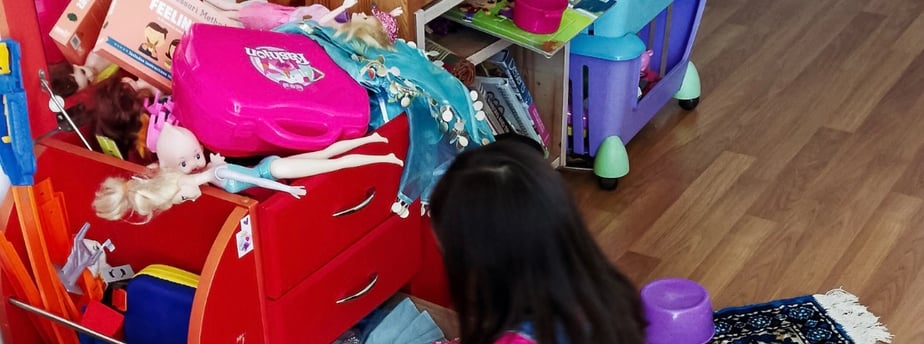Why We Rotate Toys: Keeping Playtime Fresh for Your Tiny Little Explorers
Toy rotation is a simple but powerful practice that can transform your child's play area and toys and help you maintain a more organised, calm space.
Kim at Tiny Little Explorers
8/5/20244 min read


What is Toy Rotation?
As parents or caregivers, we all want to provide the best environment for our little ones to explore, learn, and grow. But let’s be real - if you’re anything like me, you’ve probably had those moments of feeling overwhelmed by the sheer number of toys scattered everywhere. Not only does it become harder to tidy up, but sometimes it feels like our children aren’t even engaging with half the toys they have.
Enter toy rotation. This simple but powerful practice can transform the way your little one plays and help you maintain a more organised, calm space. Let’s dive into why rotating toys can be a game-changer for your tiny explorer and how to ensure that the toys you offer are safe, engaging, and age-appropriate.
Toy rotation is exactly what it sounds like - switching out toys regularly so your child doesn’t have access to every single one all the time. Instead, you only leave out a limited number of toys for a period of time (usually a week or two), then swap them with others. This way, they get the excitement of “new” toys without you having to buy anything new.
Think of it like a mini toy library at home - fresh, stimulating, and not overwhelming.
The Benefits of Rotating Toys
Now that we know what toy rotation is, let’s get into the good stuff - why you should consider doing it:
Reduces Overwhelm: Ever noticed how a mountain of toys can lead to your child hopping from one thing to another, or worse, saying “I’m bored” despite having so much to play with? Having too many options can overwhelm them, making it hard to focus on any one activity. By rotating toys, you create a more manageable selection that encourages deeper, more meaningful play.
Boosts Creativity: Fewer toys mean your child is more likely to use their imagination. When a toy feels new (even though it’s not!), they approach it with fresh curiosity. You’ll often find them playing in more creative ways or even combining toys in ways they hadn’t before. With fewer distractions, they tend to get more inventive with the options in front of them.
Sparks Interest in ‘Old’ Toys: There’s nothing like the joy of rediscovering something you’ve forgotten about—kids feel the same way! When toys are brought back into rotation after a little break, they feel exciting and new again. Your child is likely to engage with them as if seeing them for the first time, keeping the magic alive without adding to your collection.
Encourages Independent Play: When the play area is less cluttered and more intentional, kids are more likely to immerse themselves in play without needing constant guidance or direction. Toy rotation promotes focus and independence, helping kids become more self-sufficient when it comes to keeping themselves entertained.
Saves Money and Reduces Clutter: One of the biggest wins for parents is that toy rotation helps curb the desire to buy more toys. When you’re rotating regularly, it feels like your child is always getting something new without you having to spend a cent. It also keeps the play space cleaner and more organised—a win-win!
Making Sure Toys Are in Good Condition, Age-Appropriate, and Fit for Purpose
Toy rotation is fantastic, but to really get the most out of it, there are a few things to keep in mind. You want to ensure that the toys you put in rotation are safe, engaging, and suited to your child’s current development stage.
Check the Condition of Toys: Before you reintroduce toys into the rotation, take a minute to check them over. Are there any broken pieces? Are the batteries working? Is the toy clean? Ensuring toys are in good shape means your child can enjoy them safely, and it avoids any frustration that could come from a toy that doesn’t work as expected. Plus, clean and well-maintained toys send a message that we value and care for the things we have.
Choose Age-Appropriate Toys: As children grow, their needs and abilities change rapidly. What excited them six months ago may no longer hold their attention. When selecting toys for rotation, make sure they’re still developmentally appropriate. For younger children, this might mean simple, sensory-based toys. For toddlers, focus on toys that challenge their motor skills or problem-solving abilities. Keep in mind that something too advanced might lead to frustration, while something too simple might not hold their interest for long.
Ensure Toys Fit Their Interests and Skills: Rotating toys doesn’t mean just randomly swapping things out. Pay attention to what your child is naturally drawn to at the moment. Are they really into puzzles, blocks, or imaginative play with dolls or trucks? Rotate toys that align with these interests while also offering a few that encourage different types of play. You might also introduce toys that challenge them to build new skills, like stacking blocks for hand-eye coordination or art supplies for creativity.
Tips for Rotating Toys
Ready to start rotating? Here are a few tips to make the process smooth and effective:
Start Small: If you’ve never rotated toys before, begin by reducing the number of toys available. Pack away a few in storage boxes or bins, and see how your child reacts.
Set a Schedule: Toy rotation can happen weekly, bi-weekly, or monthly - whatever feels right for you and your child. Find a rhythm that works for your household.
Consider a toy swap: Swapping toys and books with friends can be great for keeping the toy area fresh, saving money on buying toys and space saving.
Keep It Simple: You don’t need to rotate every single toy. Maybe keep out a favourite or two while introducing a few “new” toys from the stash.
Observe and Adjust: Watch how your child interacts with the toys you’ve chosen. Are they engaging for long stretches? Or do they lose interest quickly? Let their behaviour guide your rotation schedule.
Toy rotation is a practical, cost-effective, and engaging way to create a balanced play environment for your Tiny Little Explorer. By making sure the toys are in good condition, developmentally appropriate, and suited to their interests, you’re setting up your child for focused, creative play while reducing clutter and chaos.
Not only will your little one benefit from the newness and excitement of rediscovering toys, but you’ll enjoy a more organised, peaceful space-making everyone happy!
So go ahead, give toy rotation a try and watch your child’s playtime transform into something even more magical. Happy exploring!
Thank you for reading,
Kim
Leave us a comment, we would love to hear what you think...
Subscribe to the Blog
BUY our book - Sensory Play:
How to Make a Sensory Bottle
FREE Resource - Books for Infants

